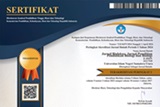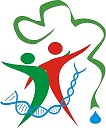Development of environmental sustainability handout based on STEM-PjBL integrated islamic values
Abstract
To holistically develop students’ potential, educators must develop integrative-interdisciplinary teaching materials. Therefore, this research aims to create environmental sustainability material handouts based on Science, Technology, Engineering, and Mathematics and Project Based Learning (STEM-PjBL) integrated with Islamic values suitable for use. The researchers conducted this research from December 2022 to May 2023. This research is research and development. The research and development approach used is the Analysis, Design, Development, Implementation, and Evaluation (ADDIE) development model developed by Dick and Carry. This research shows that the handout developed contains STEM and PjBL components for eco enzyme production project activities. The researchers added Islamic values in the sub-discussion titled Islamic values related to environmental preservation. This sub-discussion explains Al-Qur’an verses and hadiths related to environmental conservation, such as ar-Rum verse 41, al-A’raf verse 56, and hadiths about the virtues of planting trees. The handouts developed are also suitable for use. The validator for the handout gave the feasibility assessment, which determines this feasibility, which received a score of 4.2 and is included in the good category.
Keywords
Full Text:
PDFReferences
Afriana, J., Permanasari, A., & Fitriani, A. (2016). Project based learning integrated to stem to enhance elementary school’s students scientific literacy. Jurnal Pendidikan IPA Indonesia, 5(2), 261–267. https://doi.org/10.15294/jpii.v5i2.5493
Agung, I. D. G., Suardana, I. N., & Rapi, N. K. (2022). E-modul IPA dengan model STEM-PjBL berorientasi pendidikan karakter untuk meningkatkan hasil belajar siswa. Jurnal Ilmiah Pendidikan Dan Pembelajaran, 6 (1), 120–133. https://doi.org/https://doi.org/10.23887/jipp.v6i1.42657
Aisyah, N., & Rosnita, R. (2021). Pengaruh Project Based Learning pada Materi Sistem Koordinasi terhadap Hasil Belajar Kognitif Siswa. Jurnal Biolokus: Jurnal Penelitian Pendidikan Biologi Dan Biologi, 4(1), 14–19. http://dx.doi.org/10.30821/biolokus.v4i1.816
Aisyah, S., Noviyanti, E., & Triyanto, T. (2020). Bahan Ajar Sebagai Bagian Dalam Kajian Problematika Pembelajaran Bahasa Indonesia. Jurnal Salaka : Jurnal Bahasa, Sastra, Dan Budaya Indonesia, 2(1), 62–65. https://doi.org/10.33751/jsalaka.v2i1.1838
AlAli, R., Alsoud, K., & Athamneh, F. (2023). Towards a Sustainable Future: Evaluating the Ability of STEM-Based Teaching in Achieving Sustainable Development Goals in Learning. In Sustainability. Vol. 15, (16). https://doi.org/10.3390/su151612542
Baran, M., Baran, M., Karakoyun, F., & Maskan, A. (2021). The Influence of Project-Based STEM (PjbL-STEM) Applications on the Development of 21st-Century Skills. Journal of Turkish Science Education, 18(4), 798–815. https://doi.org/10.36681/tused.2021.104
Branch, R. M. (2009). Instructional Design: The ADDIE Approach. Springer. https://doi.org/978-0-387-09505-9
Budiariawan, I. P. (2019). Hubungan Motivasi Belajar Dengan Hasil Belajar Pada Mata Pelajaran Kimia. Jurnal Pendidikan Kimia Indonesia, 3(2), 103. https://doi.org/10.23887/jpk.v3i2.21242
Connors-Kellgren, A., Parker, C. E., Blustein, D. L., & Barnett, M. (2016). Innovations and Challenges in Project-Based STEM Education: Lessons from ITEST. Journal of Science Education and Technology, 25(6), 825–832. https://doi.org/10.1007/s10956-016-9658-9
Cooper, R., & Heaverlo, C. (2013). Problem Solving And Creativity And Design: What Influence Do They Have On Girls’ Interest In STEM Subject Areas? American Journal of Engineering Education, 4. https://doi.org/10.19030/ajee.v4i1.7856
Depdiknas. (2008). Panduan Pengembangan Bahan Ajar. Depdiknas.
Fajria, R., Yerizon, Y., Musdi, E., & Permana, D. (2022). Pengembangan Perangkat Pembelajaran Matematika Model Project Based Learning Terintegrasi Stem Untuk Meningkatkan Kemampuan Berfikir Kreatif Peserta Didik Kelas VIII SMP. JEMS: Jurnal Edukasi Matematika Dan Sains, 10(1), 92–102.
Hamid, S., Ijab, M. T., Sulaiman, H., Md. Anwar, R., & Norman, A. A. (2017). Social media for environmental sustainability awareness in higher education. International Journal of Sustainability in Higher Education, 18(4), 474–491. https://doi.org/10.1108/IJSHE-01-2015-0010
Jatmika, S., Lestari, S., Rahmatullah, R., Pujianto, P., & Dwandaru, W. S. B. (2020). Integrasi Project Based Learning dalam Science Technology Engineering and Mathematics untuk Meningkatkan Keterampilan Proses Sains dalam Pembelajaran Fisika. Jurnal Pendidikan Fisika Dan Keilmuan (JPFK), 6(2), 107. https://doi.org/10.25273/jpfk.v6i2.8688
Kurniasih, I., & Sari, B. (2014). Panduan Membuat Bahan Ajar Buku Teks Pelajaran Sesuai Dengan Kurikulum 2013. Kata Pena.
Lou, S.-J., Chou, Y.-C., Shih, R.-C., & Chung, C.-C. (2017). A Study of Creativity in CaC2 Steamship-derived STEM Project-based Learning. Eurasia Journal of Mathematics, Science and Technology Education, 13(6), 2387–2404. https://doi.org/https://doi.org/10.12973/eurasia.2017.01231a
Mendikbud. (2018). Peraturan Menteri Pendidikan dan Kebudayaan RI No. 37 Tahun 2018 tentang Kompetensi Inti dan Kompetensi Dasar Pelajaran pada Kurikulum 2013 pada Pendidikan Dasar dan Pendidikan Menengah.
Mulyatiningsih, E. (2014). Metodologi Penelitian Terapan Bidang Penddidikan. Alfabeta.
Peraturan Menteri Pendidikan Nasional Nomor 16 Tahun 2007 Tentang Standar Kualifikasi Akademik Dan Kompetensi Guru., (2007).
Nurulloh, E. S. (2019). Pendidikan Islam dan Pengembangan Kesadaran Lingkungan. Jurnal Penelitian Pendidikan Islam, 7(2), 237. https://doi.org/10.36667/jppi.v7i2.366
Pingge, H. U., Suluh, M., Lede, Y. A., & Kaleka, Y. U. (2021). Pengembangan Handout Materi Suhu Dan Kalor Berbasis Kontekstual Untuk Siswa Kelas XI IPA Sekolah Menengah Atas. Jurnal Edukasi Sumba (JES), 5(2), 24–30. https://doi.org/10.53395/jes.v5i2.424
Prabowo, A., Rahmawati, U., & Anggoro, R. P. (2019). Android-based Teaching Material for Statistics Integrated with Social Media Whatsapp. International Journal on Emerging Mathematics Education, 3(1), 93. https://doi.org/10.12928/ijeme.v3i1.11961
Prastowo, A. (2015). Panduan Kreatif Membuat Bahan Ajar Inovatif. Diva Press.
Raharjo, S. T. (2016). Pengembangan Bahan Ajar Handout Sistem Penerima Televisi di SMK PIRI 1 Yogyakarta [Universitas Negeri Yogyakarta]. https://eprints.uny.ac.id/39228/
Rahmadana, A., & Agnesa, O. S. (2022). Deskripsi Implementasi Steam (Science, Technology, Enginering, Art, Mathematic) dan Integrasi Aspek “Art” Steam pada Pembelajaran Biologi SMA. Journal on Teacher Education, 4(1), 190–201. https://doi.org/10.31004/jote.v4i1.5838
Ritzer, G. (1980). Sociology, A Multiple Paradigm Science. Allyn And Bacon Inc. https://www.jstor.org/stable/27702185
Robert J. DeFillippi. (2001). Introduction: Project-based Learning, Reflective Practices and Learning Outcomes. Management Learning, 32(1), 5–10. https://journals.sagepub.com/doi/abs/10.1177/1350507601321001?journalCode=mlqb
Rokhim, D. A., Widarti, H. R., & Fajaroh, F. (2020). Pengembangan bahan belajar flipbook pada materi redoks dan elektrokimia berbasis pendekatan STEM-PjBL berbantuan video pembelajaran. Kwangsan: Jurnal Teknologi Pendidikan, 8(2), 234–250. https://core.ac.uk/download/pdf/327690858.pdf
Sardiman, A. M. (2014). Interaksi dan Motivasi Belajar Mengajar. Rajawali Press.
Stevany, L. Y. (2017). Pengembangan Handout Berbasis Pendekatan Contextual Teaching And Learning (CTL) Pada Materi Zat Aditif Makanan Untuk Siswa SMP Kelas VIII [Universitas PGRI Sumatera Barat]. https://repo.stkip-pgri-sumbar.ac.id/id/eprint/2666/
Sugiyono. (2019). Metode Penelitian Kuantitatif, Kualitatif, dan R&D. Alfabeta.
Suryani, Y. (2024). E-LKM Berbasis PJBL Terintegrasi Etno-STEM pada Materi IPA dalam Menumbuhkan Karakter Peduli Lingkungan pada Mahasiswa. In A. Wijayanto, E. Rahmadhani, M. A. Mubarok, D. A. Fajarianingtyas, & A. Arifuddin (Eds.), Harmoni Media dan Metode dalam Pembelajaran IPA. Akademia Pustaka. Hal : 108. https://www.researchgate.net/publication/379046269_Harmoni_Media_dan_Metode_dalam_Pembelajaran_IPA
Susilowati, S. (2017). Pengembangan Bahan Ajar IPA Terintegrasi Nilai Islam untuk Meningkatkan Sikap dan Prestasi Belajar IPA Siswa. Jurnal Inovasi Pendidikan IPA, 3(1), 78. https://doi.org/10.21831/jipi.v3i1.13677
Triastuti, E. (2020). Model pembelajaran STEM PJBL pada pembuatan ice cream melatih keterampilan berfikir kreatif dan wirausaha. Ideguru: Jurnal Karya Ilmiah Guru, 5(2), 67–74. https://doi.org/https://doi.org/10.51169/ideguru.v5i2.159
Utami, R., & Darmana, A. (2020). Inovasi Bahan Ajar Berbasis Pendekatan SETS (Science, Environment, Technology, and Society) Terintegrasi Nilai Islam Terhadap Peningkatan Hasil Belajar Siswa Pada Materi Laju Reaksi. Prosiding Semnaskim Jurusan Kimia FMIPA Universitas Negeri Medan. https://digilib.unimed.ac.id/id/eprint/43192/
Widoyoko, E. P. (2016). Teknik Penyusunan Instrumen Penelitian. Pustaka Pelajar.
DOI: http://dx.doi.org/10.30821/biolokus.v7i1.3402
Refbacks
- There are currently no refbacks.
Copyright (c) 2024 Jurnal Biolokus: Jurnal Penelitian Pendidikan Biologi dan Biologi
indexed by :












